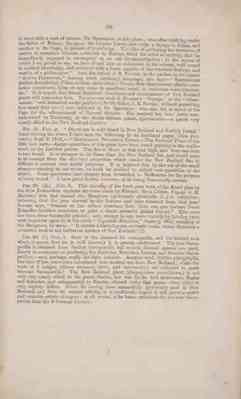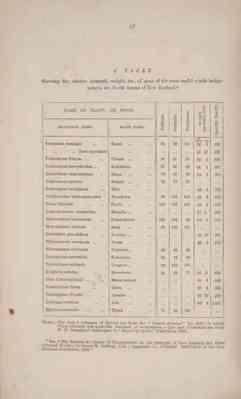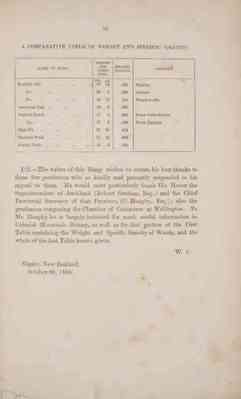Pages
56 to meet with a man of science, Dr. Sparmann, at this place; who after studying under the father of Botany, the great Sir Charles Linne, had made a voyage to China, and another to the Cape, in pursuit of knowledge. The idea of gathering the treasures of nature in countries hitherto unknown to Europe, filled his mind so entirely, that he immediately engaged to accompany us on our circumnavigation; in the course of which I am proud to say, we have found him an enthusiast in his science, well versed in medical knowledge, and endowed with a heart capable of the warmest feelings, and worthy of a philosopher." And, the father, J.R. Forster, in the preface to his classic "Genera Platarum," ( among much laudatory language) also says -"Sparmannus plantas describebat, Filius easdem delineabat. - Verum dum Sparmannus plantas accuratius examinaret, filius et ego saepe in consilium vocati in commune consulebamus, &c." It is hoped, that future Botanical describers and nomenclators of New Zealand plants will remember this. No man can read G. Forster's "Voyage," or the "Obser -vations" and Botanical works published by his father, J.R. Forster, without perceiving how much they (we?) were indebted to Dr Sparmann; who also did so much at the Cape for the advancement of Natural Science. His memory has been justly com -memorated by Thunberg, in the South-African genus, Sparmannia, - a genus very closely allied to the New Zealand Entelea.
Par. 19. Note, g. "Phormium is only found in New Zealand and Norfolk Island." Since writing the above I have seen the following in an Auckland paper, (New Zea -lander, Sept. 2, 1864,) - "AUSTRALIAN PHORMIUM TENAX - The Pastoral Times of the 13th inst. says - Large quantities of this plant have been found growing in the mallee scrub on the Lachlan plains. The flax is three or four feet high, and from one inch to two broad. It is stronger inits fibres than the New Zealand flax, and would seem to be exempt from the oily (sic) properties which render the New Zealand flax so difficult to convert into useful purposes. It is believed that by the aid of the small steamers running up our rivers, we shall be enabled to collect vast quantities of the article. Some specimens have already been forwarded to Melbourne for the purpose of being tested." I have great doubts, however, of its being Botanically correct.
Par. 23. (iii.) Note, h. This chewing of the fresh gum resin of the Kauri pine by the New Zealanders, explains the error made by Forster, (from Crozet, Voyage de M. Marion,) who had named the Mangrove (Avicennia officinalis, L.,) A. resinifera; believing that the gum chewed by the Natives had been obtained from that tree! Forster says, "Gummi ex hac arbore exsudans forte idem est, quo barbari Novae Zelandiae homines vescunter ut patet e diaris navarchi galliei Crozet." This error has been sincerepeatedly printed; and, strange to say, more recently by Lindley (who even improves upon it) in his noble "Vegetable Kingdom" where (p. 665,) speaking of the Mangrove, he says - "It exudes a kind of green aromatic resin, which furnishes a miserable food to the barbarous natives of New Zealand." (!)
Par. 30, (i.) Note, i. Such is the demand for sarsaparilla, and the limited area where it grows, that (as is well known,) it is greatly adulterated. The true Sarsa -parilla is obtained from Smilax Sarsaparilla, but several distinct species are used, known in commerce as producing the Peruvian, Brazilian, Lisbon, and Jamaica Sarsa parillas, - and, perhaps, really but little inferior. Another kind, Smilax glycyphylla, has also of late years been introduced into medical use from New Holland; while the roots of 3 sedges, (Carex arenaria, hirta, and intermedia,) are collected to make German Sarsaparilla! The New Zealand plant (Rhipogonum parviflorum,) is not only very nearly allied to the genus Smilax, but was by its first discoverers, Banks and Solander, and subsequently by Forster, classed under that genus - from which it only slightly differs. From its having been successfully (privately) used in New Zealand, and from its natural affinity, it is confidently hoped, it will prove a useful and valuable article of export; at all events, a far better sustitute for the true Sarsa -parilla than the 3 German Carices.
57
A TABLE Shewing the relative strength, weight, &c., of some of the most useful woods indigenous to the North Island of New Zealand.*
[Table]
Note-- the first three columns of figures are from the "Churh Almanac" for 1847; in which Vitex littoralis was made the standard of comparision.--The last 2 columnsare from W. W. Sanders's Catalogue, in "Report of Juries," Exhibition, 1851.
*See, "The Results of a Series of Experiments on the Strength of New Zealand and other Colonial Woods; by James M. Balfour, C.E.; Appendix C., JURORS' REPORTS of the New Zealand Exibition, 1865."
58
A COMPARATIVE TABLE OF WEIGHT AND SPECIFIC GRAVITY
[table]
PS:- The writer of this Essay wishes to return his best thanks to those few gentlemen who so kindly and promptly responded to his appeal to them. He would most particularly thank His Honor the Superintendent of Auckland (Robert Graham, Esq.,) and the Chief Provincial Surveyor of that Province, (C. Heaphy, Esq.); also the gentlemen composing the Chamer of Commerce at Wellington. To Mr Heaphy he is largely indebted for much useful information on Colonial (Economic Botany, as well as for that portion of the First Table containing the Weight and Specific Gravity of Woods, and the whole of the last Table herein given. W. C. Napier, New Zealand, October 26, 1864.
This page is blank
This page is blank




